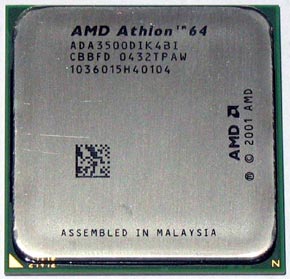AMD’s 90nm Winchester CPU
Introduction
In February of this year, Intel released their first 90nm processor, code name Prescott. With a new architecture that promised everything from better energy efficiency to cooler temperatures to improved performance, the Prescott was arguably a failure. Hindered by extreme temperatures and disappointing performance, the Prescott was blasted by enthusiasts and reviewers alike for both its temperature issues (See the Prescott Survival Kit) and its performance as measured against the CPU it was designed to replace, the P4 Northwood.
Intel’s “failure” to win hearts with the Prescott and AMD’s notable absence from the 90nm CPU field has led many to question whether 90nm CPUs were worth the issues they raised. A little more than six months later, shortly after releasing the socket 939 Newcastle, AMD has quietly released the 90nm Winchesters in 3000+, 3200+, and 3500+ for the socket 939. Noticeably absent from this list are the new 4000+ and FX-55 (The good news here is that AMD says their FX series of processors will make the jump to 90nm sometime during the first half of 2005).

Did AMD wait to see how Intel handled the thermal issues with the Prescott, or did they wait because they were having issues of their own moving from 130 to 90nm? After talking to a source at AMD, I was told that neither was the case. Instead it was simply a case of AMD choosing to work at their own pace on the 90nm processor, and only releasing it when they were satisfied with the end product (I wish all companies took this approach!!! Are you listening motherboard makers?). Next was the rumor that the new 90nm processors would include changes to improve performance, most notably to the on die memory controller. There was also talk that the < ?xml:namespace prefix = st1 ns = "urn:schemas-microsoft-com:office:smarttags" />
AMD has said that the major difference between the Winchester and Newcastle CPUs is that their 90nm CPU actually runs much cooler and consumes far less energy than its 130nm brethren. If the CPU does in fact run cooler and consumes less energy, does that make it a better overclock candidate than the 130nm chip? Again, we’ll see later.

Comments are closed.